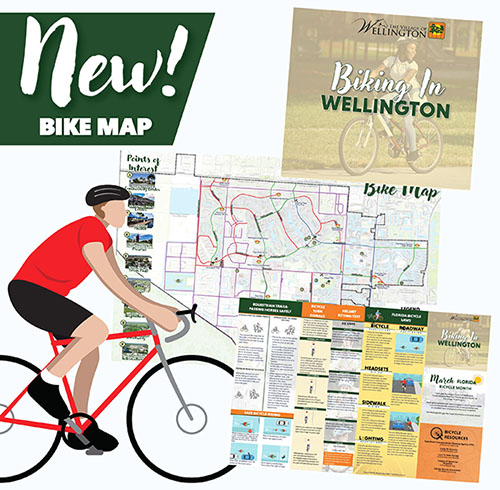Wellington offers a beckoning variety of places to ride bicycles, a new village brochure highlights, but it also leans into detailed safety information following studies showing that nearly one in 10 fatal or incapacitating traffic incidents in the community involve bikes.
“With this new resource, we’re empowering our community to enjoy all the benefits of cycling while staying informed about safety and local biking laws,” Village Manager Jim Barnes said.
The brochure, announced Nov. 22, includes a map showing miles of designated bike lanes, shared-use pathways, off-trail paths and even bicycle fix-it stations.
The safety information reviews bicycle laws, a helmet fitting guide and other matters. Some laws are generally well-known, if not observed with universal fidelity, such as don’t carry more passengers than there are seats on the bicycle. That generally means one person apart from the odd bicycle built for two.
Other regulations might escape attention on occasion.
“A bicyclist may not wear a headset, headphone or other listening device, other than a hearing aid, when riding,” the brochure notes.
There’s a reason for that.
“Wearing a headset blocks out important audio clues needed to detect the presence of other traffic,” it continues.
On sidewalks, bicyclists have the same rights and duties as pedestrians. Still, there are some obligations not always honored in actual practice.
“A bicyclist riding on sidewalks or in crosswalks must yield the right-of-way to pedestrians and must give an audible signal before passing,” the brochure notes.
That can be a bell or voiced warning, for example.
One set of protocols for bicyclists is not likely to come up in just any community, because Wellington features a wide range of equestrian trails that may host cyclists as well.
The village brochure lists recommended practices for bicyclists approaching a horse in front or behind. Here is one example of advice about approaching from behind: “Speak to the rider and horse in a friendly, relaxed tone. Remove your helmet if it conceals part of your face. The horse will be more likely to recognize you as a human.”
The rules of the road are not always just about courtesy but can involve serious safety issues as well.
Pedestrians and bicycles were involved in 21 of Wellington’s 132 collisions resulting in death or incapacitating injury in the 10 years ending in 2022, according to an analysis by consultants working for the village. That’s about one in six.
Bicycles alone were part of almost one in 10 of such incidents, research for the village’s Vision Zero project found. The project’s goal is to reduce traffic deaths and serious injuries as close as possible to zero by 2030.
Still, the warm weather and subtropical setting generate lasting appeal, and there have never been more choices available to those who want to get on two wheels and pedal in Wellington. These range from bike lanes on busy thoroughfares such as Forest Hill Blvd. or Wellington Trace, to paths in suburban neighborhoods, to sometimes unpaved trails in conservation and recreation areas.
“I think the interest in the sport is growing,” said Ivan Gonzales, salesman at Cycle Fit Bicycles in Wellington. “With all these options, it’s very attractive.”
Expanding choices include e-bikes, which provide a little electric power to supplement pedaling, and gravel bikes, with wider tires to handle the more rugged and outdoorsy paths, he said.
Wellington’s new brochure can be downloaded at the village web site, or residents can pick up a copy at several locations. These include Village Hall (12300 W. Forest Hill Blvd.), the Wellington Community Center (12150 W. Forest Hill Blvd.), Village Park (11700 Pierson Road), the Neil S. Hirsch Family Boys & Girls Club (1080 Wellington Trace) and the Palm Beach County Sheriff’s Office District 8 substation (14000 Greenbriar Blvd.).
To download the village’s bicycle map and brochure, visit www.wellingtonfl.gov/2271/16492/Bicycles-Pedestrians.








